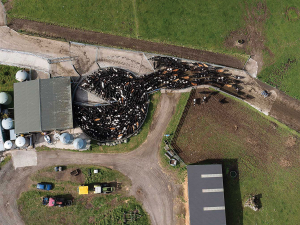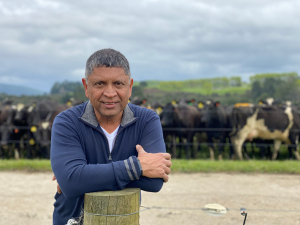To answer these questions, we used energy data from the farm, along with models of solar power, wind power, load management and battery storage to create an energy simulation. We also included costs and different electricity pricing structures.
An important concept when considering renewable energy is to, whenever possible, align your load with times when generation is high. Make hay when the sun is shining!
Different plans
Farmers have options when trading with electricity retailers. A fixed price plan means that the electricity price is constant, whereas a time of use plan means that there are different prices depending on the time of day. The price paid to a farmer for selling electricity to the grid (exporting) is generally less than the price for purchasing electricity (importing).
Solar generation
Solar panels are a practical way to address rising electricity prices. For example, on our case study farm, the installation of a 126kW (kilowatt, a measure of electric power) solar array resulted in an annual electricity cost saving of $26,000. Furthermore, when the sun is shining and demand is low, extra electricity is sold back to the grid.
On most dairy farms, highest electricity demands occur in the morning and afternoon milkings. To suit this demand, an east–west facing rooftop solar array was explored, as this configuration captures the morning and afternoon sun. North facing panels will generate the most electricity, but the time of generation does not necessarily match when demand occurs.
Overall, we found that a north-facing groundmounted array suited the demand profile of the case study farm, but this could come at a cost associated with lost pasture. Because the timing of solar generation often doesn’t match the peaks in farm demand, farmers need strategies to make the most of their solar generation. Two key options are load management, such as shifting activities like water heating to midday, and energy storage, where batteries store excess power for later use.
You’ll save the most money when your solar is covering your own daytime loads – things like water heating, milk chilling, and effluent pumping.
Wind generation
New Zealand is a windy place, so why not take advantage of that with wind power? Wind can complement other renewable energy power sources (e.g. solar); when it’s not sunny, it might be windy. However, there are a few problems with wind power. Smallscale wind power isn’t cheap to install, and wind conditions must be optimal. Windspeed increases with height above the ground. As a result, small-scale installations wouldn’t get as much wind as large, utility scale turbines, that can be over 100 metres tall.
If you’ve noticed strong winds that send your hats flying or your trees that grow at an angle, it might be worth checking out. A great way you can see for yourself is by going to globalwindatlas.info and looking into the projected wind resource at your farm's location. If the numbers say you are getting into average wind speeds of around 9 m/s (~30 km/h) and you are interested in how renewable energy could support your farm, then wind generation could be worth considering.
However, for the dairy farms we modelled, wind power generally did not stack up financially, with payback periods on some turbines being greater than 20 years.
While wind isn’t the right fit for every farm, in the right location it can be a powerful addition towards a sustainable farm.
Key Points
The dairy farm we focused on is in Matamata, with 600 cows and a 54-bale rotary shed. Our client wanted to investigate on-farm electricity generation, storage, and usage. Rooftop solar was installed in in 2024 and the farm changed from gas to electric hot water heating in 2025.
We wanted to answer:
- What orientation and arrangement of solar panels will best match the timing of dairy farm electricity demand?
- Should the case study farmer install a wind turbine to complement their solar system?
- How can farmers change when they use power to match the cheapest electricity?
- Under what circumstances is on-farm energy storage, such as batteries, financially viable?
Conclusion
Any investment in on-farm renewable energy is a long-term investment. If a system is designed around a large net export of energy to the grid, it is important to understand that it is difficult to predict the electricity pricing plan over the lifetime of the asset. Designing a smaller system and targeting higher self-consumption means that the farm will be more independent from the grid. This makes the return on investment less susceptible to a changing energy market.
















